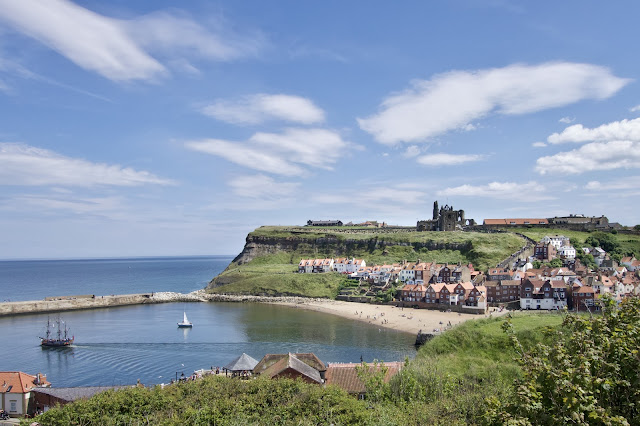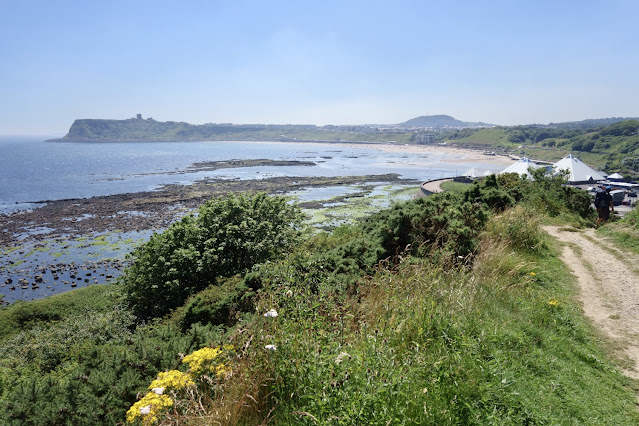Ingleborough (Yorkshire Three Peaks)
In mid September I decided to take a holiday, but instead of
going away for an entire week I chose to have extended weekend breaks at each
end of my week's leave. It was time, I had decided, to climb a little
higher.
The first weekend was spent in the Yorkshire Dales at Ingleton,
my aim being to climb my second Yorkshire Three Peaks mountain -
Ingleborough. At 2,372 feet (723 metres), Ingleborough is
the second highest mountain in Yorkshire, just under 100 feet higher than
Pen-y-Ghent's 2,277 feet and only 43 feet less than Whernside's 2,415
feet. There are several routes of
ascent, but as our base was the village of Ingleton we decided to leave from
the car park of the pub where we were staying for a couple of nights. The weather was perfect for our walk - blue sky, sunshine and only a light breeze. As we set off along the lane towards Ingleborough the ascent was gentle and across the fields, over the limestone valley, we could see the distant peak of Whernside.
Along the lane Ingleborough beckoned. It looked quite daunting from this level, a
mass of grey shale and plateaus, although a path was faintly discernible,
winding its way through the lower grassy slopes.
The lower slopes
entailed some highly enjoyable walking, which wasn't too strenuous and offered
some sumptuous views of the mountain which, strangely, seemed to be further
away with each step.
Even on the steepest
part of the ascent the mountain would fool us, as each plateau was climbed, yet
more waited, and each one felt like it should be the summit. I
found it quite tough going at times and it didn't help that when I stopped for
a breather I was overtaken by a three-legged dog who, along with his owner,
scampered along and upwards with complete ease. I had already decided that the following
weekend I was going to attempt to climb one of the Lake District's highest
mountains (Skiddaw) and I mentioned this to a lady who stopped for a chat as
she passed us on her descent. "Skiddaw
isn't any harder than this one", she commented. "It's just that Skiddaw is much
longer". I took encouragement from
this and pretty soon afterwards the broad plateau of Ingleborough's summit
opened up before us. The summit is
actually half a mile in circumference, but even so it was pretty crowded up
there with groups of people huddled around the central cairn and what appeared
to be a school trip.
On the summit we enjoyed a picnic lunch whilst watching a
hang glider swooping and soaring along the valley. The view was magnificent! On a clear day, such as this was, you can see
the peaks of Snaefell on the Isle of Man (84 miles) and as far as Manod Mawr in
Snowdonia (103 miles). The Lakeland
fells stretch along the western horizon - Great Gable, Scafell, Helvellyn,
Grasmoor and High Street to name a few - all calling me to climb them in the
future.
The summit of Ingleborough in itself is a fascinating place
with a rich history of its own. The word
"borough" or "burgh" means "fort", and this was
once the site of a large Iron Age hillfort settlement, the home of the
Brigantes, the largest tribe in Celtic Britain.
In fact, It may be that this was a base for Venutius who led several
rebellions after his 'divorce' from Cartimandua
the Brigante's Queen who was a supporter of the Roman invaders.
Ingleborough 's rich heritage doesn't just include what's
visible above ground. It's just as
well-known for what lies beneath in its network of potholes and caverns. Two of these are open to the public as show
caves. Ingleborough Cave is situated on
the south side of the mountain and was first opened to public viewing in
1837. White Scar Caves were discovered
in 1923 and have been open to the public since 1925. Situated to the west of Ingleborough, on the
main road from Ingleton to Hawes, White Scar is the longest show cave in the
UK. In addition to these two cave systems
open to public view, Ingleborough hides a network of caves accessible only by properly trained and equipped
cavers. The most famous of these caverns
is Gaping Gill, a 322 feet deep pothole with the stream Fell Beck flowing
into it. After falling through one of
the largest known underground chambers in Britain (comparable in size to York
Minster), the water disappears into the boulder-strewn floor and eventually
resurges adjacent to Ingleborough Cave.
I was very keen to visit the entrance to Gaping Gill, which
necessitated a partial descent of Ingleborough followed by an ascent again to
take us back to the path we needed to follow back to Ingleton. I had read that at certain times of year (on
public holidays) the Bradford Caving Club will winch members of the public down
into Gaping Gill for the payment of a fee, and I wanted to see for myself what
the cave entrance was like. I had an
idea I might like to try this, but having peered down into that hole, I'm not
so sure now!
After a brief rest at Gaping Gill we were faced with a
second ascent of Ingleborough - not quite all the way up, but almost. And this ascent, although well laid out with
paving slab steps, was even tougher than our original route. Once at the top of Little Ingleborough (just
over 2,000 feet) we found a path steeply down towards Ingleton. That was two Three Peaks down - one to go!
Finally for this blog entry, a few words about the village
of Ingleton and our base for the weekend, the Wheatsheaf Inn.
Situated on the western edge of the Yorkshire Dales National
Park, Ingleton is an excellent base for visiting the area. There are several pubs and guest houses and
apart from the nearby Three Peaks and Ingleborough's caves, there is also the
very beautiful Ingleton Waterfalls Trail.
This is a four mile circular route taking in several spectacular waterfalls
and areas of outstanding beauty. The
land is all privately owned and an admission charge is made to take part in the
trail, but having visited here previously I can confidently say I believe it's well worth
paying to see.
The village of Ingleton hosts several special events
throughout the year and it just so happened our stay coincided with their annual
Wild West Weekend which, to be honest, I found totally bizarre. To see American Civil War soldiers and
partially-clad squaws wandering around the small village was surrreal! Apparently, there was a battle re-enactment
on both the Saturday and the Sunday, which we managed to avoid (not my thing!). In the village there are a couple of specialist
walking/caving shops and situated on the outskirts by the main road is
Daleswear, a large outdoor clothing and equipment retailer which stocks an excellent
range of reasonably priced merchandise. The second day of our weekend was very wet, so I spent a very happy couple of hours shopping here.
The Wheatsheaf Inn turned out to be a bit of a find for us. As walkers we like to stay in a certain type
of place. We're not into hostels or bunk
barns, but at the same time neither are we keen on places that are too
fancy. What we like most of all is a
good honest pub/inn where muddy boots are welcomed, with good food and beer and
all the usual amenities and comforts, such as en suite, TV, tea and coffee
making facilities, etc. We're not
bothered if the decor is dated, as long as the room is clean and the
temperature can be regulated by means of a radiator and a window that opens. The Wheatsheaf Inn met all these
requirements...and some! Excellent food, comfortable (but not too fancy)
room, great beer and friendly staff. We
certainly plan on staying there again one day.
I was sad to be leaving Ingleton after just a couple of
nights, although at the same time I was both excited and apprehensive about the
trip I had planned for the following weekend - a visit to Keswick in the Lake
District and (I hoped) an ascent of Skiddaw, which will be the subject of my
next blog entry.











Comments
Post a Comment